So what can you build with dry stone?
For those in the know, dry stone is an amazing building material. Using nothing to bind it, bar the way the stones are placed together by the skill of the waller, there is a huge variety of structures and features that can created. Traditional dry stone walling in the UK was all about building livestock proof boundaries or retaining walls to hold up earth banks. Consequently much of the work that I do is a development of this type of walling – traditional in a contemporary setting; usually for clients in their gardens.
However, there is so much more going on with stone, and so in this article, I wanted to demonstrate, describe and show what can be done. Today’s post is really an infomercial or an advertorial celebrating dry stone walling in some of its fantastic forms.
Many of the images below are my own work (well, I am promoting Stone Inspired); some are not. For instance, I have no shame in admitting that I have never built an arch or a bridge – mainly because I have never been asked to do one! However, other people have. I would love to do something like an arch. This is one of the reasons why I love walling as a career: the learning never stops.
The images and text below show some of the more common types of walls and some of the more interesting uses of stone.
Thanks to the John Shaw-Rimmington, Thea Alvin for the use of their pics.
Free-standing walls
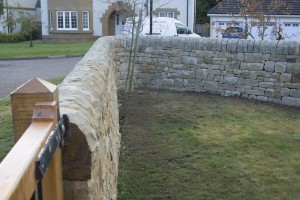 Free-standing boundary walls – straight or curved – are self-supporting structures built with a classic capital A-shaped profile (wider at the base than the top). The usual dimensions for farm stock walls are 4′ 6″ or 1.2m high, although you could in theory build as high as you liked. Long through-stones are placed at regular intervals and at about half height to provide strength.
Free-standing boundary walls – straight or curved – are self-supporting structures built with a classic capital A-shaped profile (wider at the base than the top). The usual dimensions for farm stock walls are 4′ 6″ or 1.2m high, although you could in theory build as high as you liked. Long through-stones are placed at regular intervals and at about half height to provide strength.
Walls can be topped off either with a semi-circular cope (as in the image) or with turf (see curved wall below).
Cheek-ends
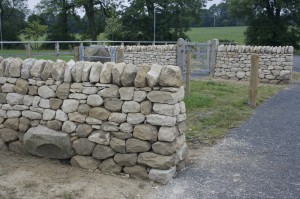 Cheek or gate ends are built into free-standing walls to provide a strong structure where the wall butts up against a gate post or such like. A good cheek-end should have stone courses running alternately length-ways and across the wall to give it strength.
Cheek or gate ends are built into free-standing walls to provide a strong structure where the wall butts up against a gate post or such like. A good cheek-end should have stone courses running alternately length-ways and across the wall to give it strength.
Retaining walls
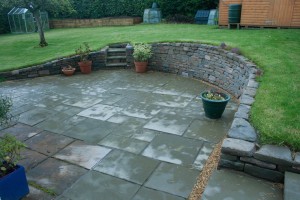 Designed to hold up earth banks, retaining walls are usually single-sided walls with one face visible. The unseen part of the structure is built of more irregular stone to provide the retaining wall with bulk to support the bank behind.
Designed to hold up earth banks, retaining walls are usually single-sided walls with one face visible. The unseen part of the structure is built of more irregular stone to provide the retaining wall with bulk to support the bank behind.
The example here is low, curving wall to provide a pretty backdrop to the paved area.
There is theoretically no limit to the height that one could be built. The only real limitations are the stength of the stone to bear the weight of the structure, and the ability to find enough stone to build with! One of the tallest dry stone retaining walls is at Cei Mawr in Wales which is more than 18m (62′) tall, and used to carry the Ffestiniog Railway’s slate trucks over it.
Steps
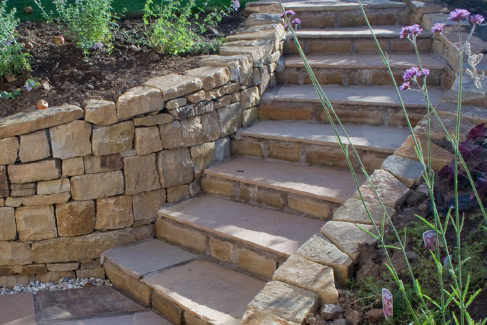 If you build a retaining wall in a garden, you generally need stairs too! The steps that I build are usually made with stone for the risers and paving slabs for the treads. These are one of only two things that I build with mortar – the other are benches made using slabs. Unfortunately, it’s unavoidable using mortar where the stone is going to be sat on or stood on.
If you build a retaining wall in a garden, you generally need stairs too! The steps that I build are usually made with stone for the risers and paving slabs for the treads. These are one of only two things that I build with mortar – the other are benches made using slabs. Unfortunately, it’s unavoidable using mortar where the stone is going to be sat on or stood on.
Curves
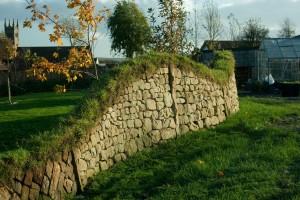 Why go straight when you can go curvy? When I build, I use metal poles and a tight string-line to keep me straight. But sometimes you’ve just got to put a nice curve in a wall. I still use poles and strings, but how do you make a bend with a straight line? Well, you need a little bit of skill and lots of practice. Its fun!
Why go straight when you can go curvy? When I build, I use metal poles and a tight string-line to keep me straight. But sometimes you’ve just got to put a nice curve in a wall. I still use poles and strings, but how do you make a bend with a straight line? Well, you need a little bit of skill and lots of practice. Its fun!
Notice that the wall is topped with a thick layer of turf.
Arches
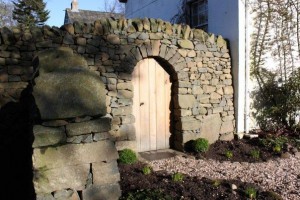 This example of an arched gateway built by Irwin Campbell is a great example of a dry stone arch. Like the bridge below, no mortar was used to build this. This is a fantastic gateway – the stone and wooden door really compliment each other.
This example of an arched gateway built by Irwin Campbell is a great example of a dry stone arch. Like the bridge below, no mortar was used to build this. This is a fantastic gateway – the stone and wooden door really compliment each other.
Bridges
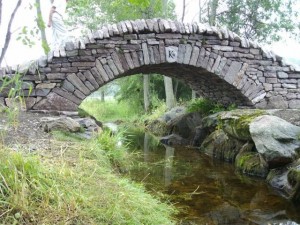 This is a dry stone bridge built by members of the Dry Stone Walling Association of Canada in Wellington (Prince Edward County) Ontario 2007. Built using the same techniques applied in the arch above, this bridge has no mortar to bind it. It’s a beautiful structure. Thanks to John Shaw-Rimmington for the use of the image. For more info go to the DSWAC website.
This is a dry stone bridge built by members of the Dry Stone Walling Association of Canada in Wellington (Prince Edward County) Ontario 2007. Built using the same techniques applied in the arch above, this bridge has no mortar to bind it. It’s a beautiful structure. Thanks to John Shaw-Rimmington for the use of the image. For more info go to the DSWAC website.
And just wow!
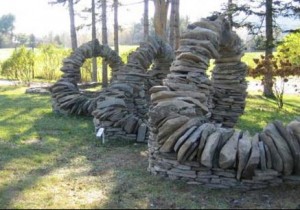 Sometimes you just have to think out of the box…
Sometimes you just have to think out of the box…
This amazing helix design is by Vermont, USA artist Thea Alvin. You see more of Thea’s work at myearthwork.com

Wow, really informative article, thanks! I’ve seen so many of these types of wall in the countyside and admired the fact that someone had to get the stone to these remote and difficult to access area’s. I never realised the finer intracasies required to build them. Great pictures too.
Very well done Jason. Is that wall in the 1st pic yours? Love it. It makes me think a bolt of fine fabric has been laid over the wall…or a sheen of smooth water.
Hi Karl, yeah, the wall in the first pic is one of mine. Thanks for the kind words. More pics here – http://www.stoneinspired.com/projects/dunblane-free-standing-dry-stone-wall/
Great stuff Jason.
Great article Jason. Very informative and gives a good indication of different structures that can be done, other than the traditional drystane walls to edge the farmers fields. Would be good to see the different bonding styles as well.
Really is a lovely building technique, done well it is hard to find a more beautiful solution.
It’s all about the old time farmers breaking new ground and saying now ,what the hell are we going to do with all these bloody stones.
Dear Jason, I don’t know if you will find this, but do you think there can be a dry stone tower, and if yes, how tall could it be? I’m writing a poem and don’t want to get it wrong, like Robert Frost…. Thanks very much for any information. Sincerely, MacKerrow
Hi
Yes, there are dry stone towers. Search for brochs on Google and you’ll get all the information and pictures on these amazing Iron Age round dry stone towers built in Scotland. No-one is entirely sure what their function was – they look like medieaval towers so there is an assumption that they were defensive structures but this is disputed.
There is a tonne of information here – https://www.thebrochproject.co.uk/what-is-a-broch. These guys are in the process of getting the planning agreed with their local authority to build a broch for the first time in 2000 years.
How tall are brochs? 16m is reckoned to be a normal height – 52ft in imperial measurements.
The Broch of Mousa on Shetland is the most complete structure still standing.
I hope that this helps.
All the best
Jason